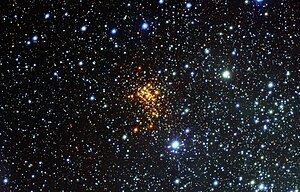Westerlund 1-237
| Observation data Epoch J2000 Equinox J2000 | |
|---|---|
| Constellation | Ara |
| Right ascension | 16h 47m 03.1075s |
| Declination | −45° 52′ 18.9572″ |
| Apparent magnitude (V) | 19.008[1] |
| Characteristics | |
| Evolutionary stage | either a red supergiant or a foreground giant[2] |
| Spectral type | M3Ia[3] or M6+ III[4] |
| Apparent magnitude (B) | 22.8[citation needed] |
| Apparent magnitude (R) | 13.634[1] |
| Apparent magnitude (G) | 11.259[5] |
| Apparent magnitude (J) | 5.075[6] |
| Apparent magnitude (H) | 3.01[6] |
| Apparent magnitude (K) | 2.18[6] |
| Absolute magnitude (MV) | –6.96[9] |
| Details | |
| if a supergiant | |
Myr | |
| if a foreground giant | |
| Radius | 216[8] R☉ |
| Luminosity | 1,000[2] or 7,178 – 7,379[8] L☉ |
| Temperature | 3,605[8] K |
| Other designations | |
Westerlund 1 W237, Westerlund 1 BKS B, 2MASS J16470309-4552189, Gaia EDR3 5940105904023386752 | |
| Database references | |
| SIMBAD | data |
Westerlund 1-237 (commonly abbreviated to Wd 1-237) or Westerlund 1 BKS B is a possible
Physical characteristics

Westerlund 1-237 is classified as a luminous cool
The star occupies the upper right corner of the Hertzsprung-Russell diagram. With an effective temperature of 3,550 K and a bolometric luminosity of 219,000 L☉, the radius of Westerlund 1-237 would be 1,241 times the solar radius (R☉), making it larger than the orbit of Jupiter. The initial mass of W237 has been calculated from its position relative to theoretical stellar evolutionary tracks to be around 28 M☉ or 32 M☉ for a non-rotating star.[9]
Distance
The distance of Westerlund 1-237 is assumed to be around 8,500+2,000
−1,300
Westerlund's 1987 analysis assigned a spectral type of M6+ III to W1-237 and considered it to be a foreground
−96 pc and a luminosity of 7,178–7,379 L☉ with a corresponding radius of 216 R☉.[14][8] In 2020, the parallax was revised to the much smaller value of 0.3370±0.1235 mas.[5]
See also
References
- ^ S2CID 119074868.
- ^ ISSN 0365-0138.
- S2CID 14780809.
- S2CID 119074868.
- ^ .
- ^ Bibcode:2003yCat.2246....0C.
- ^ S2CID 53393926.
- ^ S2CID 148571616.
- ^ .
- ^ "APOD: 2017 June 20 - The Massive Stars in Westerlund 1". apod.nasa.gov. Retrieved 2020-06-21.
- ^ "Cl* Westerlund 1 W 237". Simbad.
- ^ S2CID 9792700.
- S2CID 119465620.
- S2CID 119289017.

